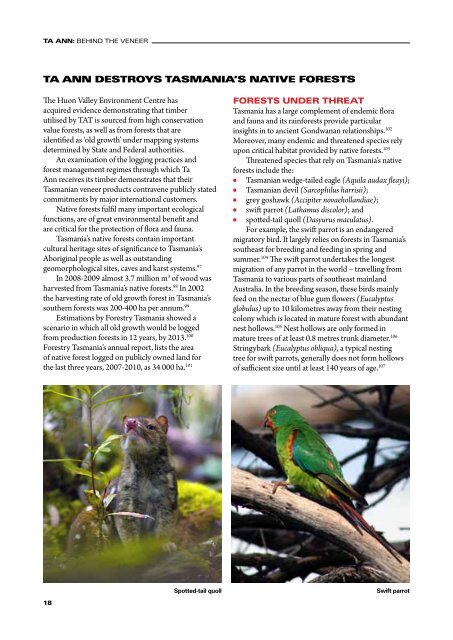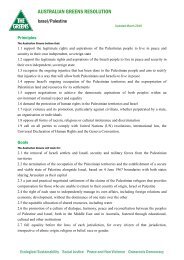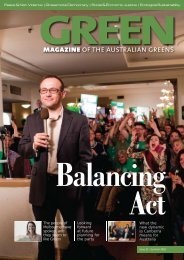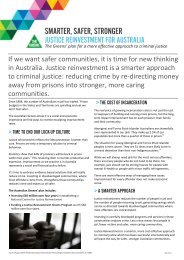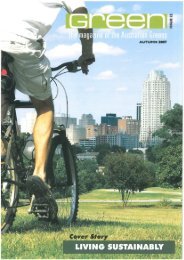Behind the Veneer - Tasmanian Greens MPs
Behind the Veneer - Tasmanian Greens MPs
Behind the Veneer - Tasmanian Greens MPs
Create successful ePaper yourself
Turn your PDF publications into a flip-book with our unique Google optimized e-Paper software.
TA ANN: BEHIND THE VENEER<br />
Ta Ann destroys Tasmania’s native forests<br />
The Huon Valley Environment Centre has<br />
acquired evidence demonstrating that timber<br />
utilised by TAT is sourced from high conservation<br />
value forests, as well as from forests that are<br />
identified as ‘old growth’ under mapping systems<br />
determined by State and Federal authorities.<br />
An examination of <strong>the</strong> logging practices and<br />
forest management regimes through which Ta<br />
Ann receives its timber demonstrates that <strong>the</strong>ir<br />
<strong>Tasmanian</strong> veneer products contravene publicly stated<br />
commitments by major international customers.<br />
Native forests fulfil many important ecological<br />
functions, are of great environmental benefit and<br />
are critical for <strong>the</strong> protection of flora and fauna.<br />
Tasmania’s native forests contain important<br />
cultural heritage sites of significance to Tasmania’s<br />
Aboriginal people as well as outstanding<br />
geomorphological sites, caves and karst systems. 97<br />
In 2008-2009 almost 3.7 million m 3 of wood was<br />
harvested from Tasmania’s native forests. 98 In 2002<br />
<strong>the</strong> harvesting rate of old growth forest in Tasmania’s<br />
sou<strong>the</strong>rn forests was 200-400 ha per annum. 99<br />
Estimations by Forestry Tasmania showed a<br />
scenario in which all old growth would be logged<br />
from production forests in 12 years, by 2013. 100<br />
Forestry Tasmania’s annual report, lists <strong>the</strong> area<br />
of native forest logged on publicly owned land for<br />
<strong>the</strong> last three years, 2007-2010, as 34 000 ha. 101<br />
Forests Under Threat<br />
Tasmania has a large complement of endemic flora<br />
and fauna and its rainforests provide particular<br />
insights in to ancient Gondwanan relationships. 102<br />
Moreover, many endemic and threatened species rely<br />
upon critical habitat provided by native forests. 103<br />
Threatened species that rely on Tasmania’s native<br />
forests include <strong>the</strong>:<br />
l <strong>Tasmanian</strong> wedge-tailed eagle (Aquila audax fleayi);<br />
l <strong>Tasmanian</strong> devil (Sarcophilus harrisii);<br />
l grey goshawk (Accipiter novaehollandiae);<br />
l<br />
l<br />
swift parrot (Lathamus discolor); and<br />
spotted-tail quoll (Dasyurus maculatus).<br />
For example, <strong>the</strong> swift parrot is an endangered<br />
migratory bird. It largely relies on forests in Tasmania’s<br />
sou<strong>the</strong>ast for breeding and feeding in spring and<br />
summer. 104 The swift parrot undertakes <strong>the</strong> longest<br />
migration of any parrot in <strong>the</strong> world – travelling from<br />
Tasmania to various parts of sou<strong>the</strong>ast mainland<br />
Australia. In <strong>the</strong> breeding season, <strong>the</strong>se birds mainly<br />
feed on <strong>the</strong> nectar of blue gum flowers (Eucalyptus<br />
globulus) up to 10 kilometres away from <strong>the</strong>ir nesting<br />
colony which is located in mature forest with abundant<br />
nest hollows. 105 Nest hollows are only formed in<br />
mature trees of at least 0.8 metres trunk diameter. 106<br />
Stringybark (Eucalyptus obliqua), a typical nesting<br />
tree for swift parrots, generally does not form hollows<br />
of sufficient size until at least 140 years of age. 107<br />
Spotted-tail quoll<br />
Swift parrot<br />
18


